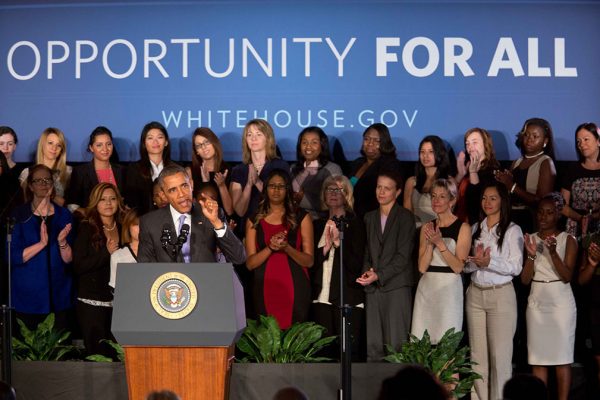Jacob Hacker and Paul Pierson provide a powerful, empirical rejoinder to pundits who assert a necessary tradeoff between economic and cultural liberalism—or who say that Democratic elites have chosen culture over the material basis of their New Deal roots. We would like to drill down on three interrelated points in response.
First, after decades of What’s the Matter with Kansas?–style arguments about working-class white people voting against their economic interests, we are less hopeful than Hacker and Pierson are about “building power through policy.” In our era of “partisan hearts and minds,” voter behavior is no longer strongly correlated with income levels, policy platforms, or even incumbent performance. Instead it is primarily driven by social identities—and class consciousness is a much less potent social identity than it used to be, at least if understood in terms of incomes. Similarly, the political feedback effects of economic policy—even very visible things like building roads and infrastructure—vary across space, and credit for these investments may be particularly hard to garner in the rural areas of recent Democratic losses. In this environment, it is unlikely that even single-minded Democratic campaign messaging on pocketbook issues—of the sort that John Judis and Ruy Teixeira call for—would lead to significant electoral wins, at least in the short term.
Muted pocketbook voting makes affluent, highly educated suburban Democrats less of a puzzle. The Republican embrace of Trumpism has repelled them. The sustained mobilization of suburban women (even before Dobbs) has been particularly notable, generating a dynamic akin to the “capture” of African American voters by the Democrats. White working-class MAGA voters are not the only ones whose partisan loyalties do not turn on policy-based appeals.
Second, we agree that Democrats have recently pursued “the most ambitious . . . agenda their party had attempted in more than half a century,” but many of the policies in their program are not really “redistributive,” as Hacker and Pierson tend to put it here. That is, they are not transfers made through the tax code (like Social Security or TANF), and they aren’t directly felt in most pocketbooks. Though Hacker and Pierson do acknowledge that “redistribution went hand in hand with predistribution,” their emphasis on redistribution misses some of the strategic features of the Democrats’ agenda.
Indeed, the policies responsible for the bulk of the ultimate fiscal impact are more properly described as government subsidies for businesses and communities. They include infrastructure projects that mostly flow through local governments and ultimately through private-sector contractors; industrial policy with significant subsidies for manufacturing in key sectors and geographic areas; and subsidies for the adoption of green technology, which accrue mostly to businesses, homeowners, and landlords (archetypal affluent suburbanites). Many of these policies are similar in structure and visibility to the broad range of tax credits that quietly redistribute money to many affluent suburbanites already. The poverty-reducing child tax credit expansion is more the redistributive exception in Biden’s agenda than the rule, and even here most affluent suburbanites benefited from it.
This may be for good reason, at least electorally. In particular, predistribution may be more politically robust than redistribution through progressive taxation. When we look beyond polarizing national party politics to the states, we find that voters have often supported predistributive measures when given a direct vote on the ballot—as with victories on the minimum wage in Nebraska, Maine, and Florida in 2020, as well as on workers’ organizing rights in Illinois in 2022. By contrast, when affluent suburbanites are offered a choice on redistribution alone, they may remain skittish. Redistribution is consistently popular in the population at large, but predistribution may be more palatable to affluent suburbanites when they get to choose from a menu.
The Biden administration appears to appreciate this need for a strategic mix of policy tools. Indeed, a key element of its predistributional agenda has been enhancing the organizational and bargaining power of workers—an element that Hacker and Pierson miss.
Biden’s National Labor Relations Board, in particular, has advanced aggressive rules and enforcement on behalf of workers pursuing collective action against powerful corporations. On his very first day in office, Biden fired the board’s Trump-appointed general counsel—a dramatic reversal of Ronald Reagan’s firing of striking PATCO workers forty years earlier. Unions have scored high-profile wins in recent years, and collective action has gained steam among the Teamsters at UPS, Hollywood writers and performers, Starbucks, Cal State faculty, and United Auto Workers at plants across the country. Unions are enjoying a historic surge in popularity among the public, and aggressive unionization campaigns have also succeeded—including a new Union of Southern Service Workers and the Steelworkers in the South. The Steelworkers’ victory, in particular, exemplifies how administrative action can advance a predistributive agenda in the absence of significant labor law reform. In that case, the EPA enforced a “no union-busting using government money” rule attached to funding from the bipartisan infrastructure act, creating an enabling condition for worker organizing in the union-hostile South. Whether predistributive or redistributive, the question to ask today is, under what conditions can policy enhance worker power?
Finally, we echo Hacker and Pierson in recognizing the long-term work of the “policy demanders” within the progressive movement—those who have invested time, ingenuity, and very hard thinking to identify and craft effective policies. In fact, even though we are skeptical that pocketbook messaging would itself lead to stronger Democratic majorities in the short term, we think that sustained parallel efforts at both party building and community organizing can help Democrats expand their coalition. And both are essential if recent policy gains are to be built upon.
Indeed, the successes of the current moment reflect a decade of work at both the grassroots and grasstops. The Democratic Party’s left turn really began with Occupy Wall Street in 2011 and the launch of Fight for $15 the following year. The party didn’t move thanks solely to internal pressure (whether from a progressive faction or new expert staffers) and the external shock of COVID-19. Social movements and community organizing were critical.
While the partisan income divide of the mid-twentieth century has largely given way to a “diploma divide” (at least among white voters), these patterns of class politics are not set in stone. They are shaped by social and community relationships and are more complex than red-blue maps allow us to see, especially due to the concentration of economic activity in metro regions. Though Trump did make significant electoral inroads in rural regions “left behind” by globalization and the knowledge economy, progressives shouldn’t assume that exurban working-class voters are lost forever—or that Democrats are now solely the party of affluent metropolitans, as analysts who draw on county- or congressional district-level electoral results often conclude.
At the end of the day, individuals are still at the heart of aggregate patterns. Engaging all Americans—no matter where they live, who they currently vote for, or whether they vote at all—needs to be a major focus of investment. The technological and ecological disruptions that await every community in the nation over the next generation will be both urgent and slow to unfold. We must embrace the patient work of meeting our fellow citizens where they are—building trust and empowering their engagement and leadership within their own communities.
Boston Review is nonprofit and relies on reader funding. To support work like this, please donate here.








